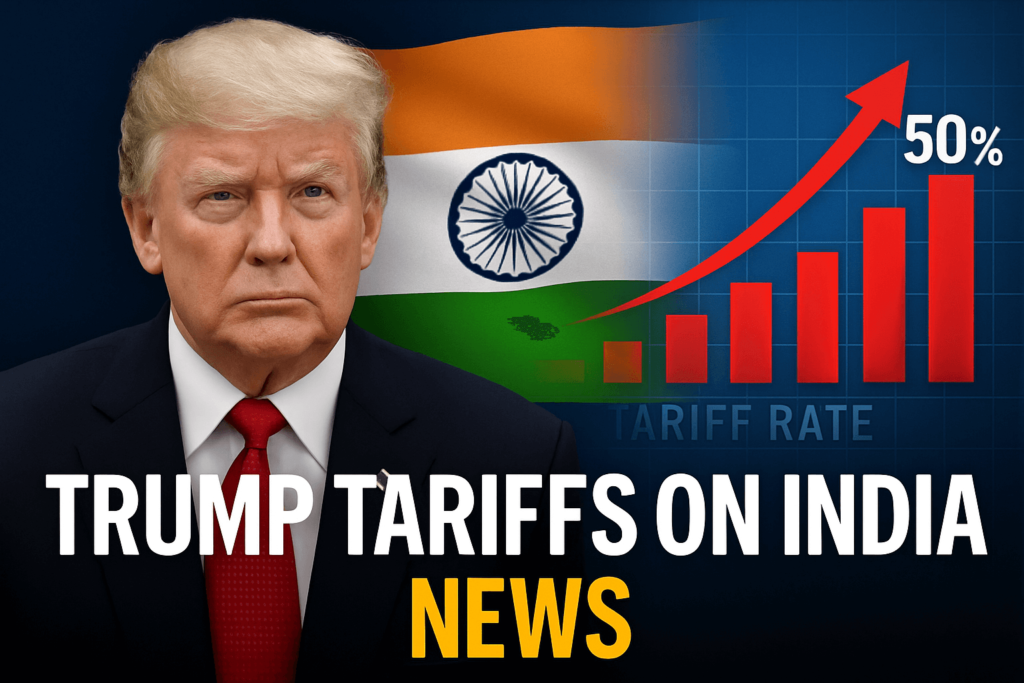Last Updated: August 2025 | Author: Shahalam, Analyst at parikshasoochna.com

Trump tariffs on India: U.S. imposed up to 50% duties under Donald Trump, impacting steel, aluminum, and key exports.
During the Trump administration (Trump tariffs on India), the U.S. imposed up to 50% tariff on India—notably steel and aluminum. These measures triggered long-term trade friction. India retaliated with duties on U.S. goods. Recent news: India’s trade ministry (MEA) still negotiates tariff relief, and Biden-era adjustments have since eased some tariffs but not all.
What Were Trump Tariffs, and How Did They Affect India?
In 2018–2019, Donald Trump imposed aggressive tariffs on steel (25%) and aluminum (10%) under Section 232. Though national security–justified, US tariffs on India heavily impacted export-oriented Indian manufacturers.
- India qualified for exclusion initially, but later lost it.
- Tariffs on iron and steel increased Indian export costs by up to 50%.
- MEA statements often criticized the move as protectionist.
Timeline of Trump‑Era Tariffs on India
| Date | Tariff Type | Impact on India |
|---|---|---|
| Mar 2018 | Steel 25% | Immediate rise in U.S. import costs |
| Jun 2018 | Aluminum 10% | Premium on India’s aluminum exports |
| Oct 2018 | Exclusion revoked | All Indian suppliers subjected to tariffs |
| May 2019 | India retaliates | Duties on U.S. apples, walnuts, lentils |
| 2021–2022 | Ongoing dialogue | MEA pushes for tariff removal exemptions |
Why Tariffs Create Tensions Between India & the U.S.
- Economic Loss for Exporters: Indian steel mills lost price competitiveness.
- Higher Inflation: End consumers in U.S. may face cost increases.
- Geopolitical Strain: MEA press releases condemned the unilateral duress.
- Local U.S. Lobbying Impact: American steel producers demanded protection.
| Join Our WhatsApp Channel | Follow here |
| Join Our Facebook Community | Follow here |
Did Trump’s Tariffs Resolve or Escalate Trade Friction?
- Short-term gains for U.S. steel producers.
- Long-term impact: Export stagnation in Indian manufacturing.
- Retaliatory tariffs and FTA negotiations remain unresolved.
- The Biden administration eased select tariff on India items, but many measures persist.
Tonight’s Trump Tariff News & Current Outlook
- No fresh 2025 tariffs under Trump; shocks subsided.
- However, talks continue over reintroducing reciprocal tariffs.
- India tariff news outlets report ongoing negotiation, especially in tech and agricultural imports.
- India-US tariff dialogue resumes around clean energy and critical minerals solidarity.
What Experts—Including Shashi Tharoor—Have Said
MP Shashi Tharoor, in Parliament and op-eds, warned that Trump’s supply-side tariffs would disrupt global value chains.
- He urged MEA to seek WTO disputes.
- He argued trade must remain rules-based, not transactional.
How Was India Affected in Trade Volume?
Indian exports of steel and iron to U.S. dropped ~40% in 2019.
Imports from U.S. stabilized, but retaliatory duties impacted pulses/walnuts.
Over time, India diversified markets—boosting exports to EU, Middle East instead.
What Does ‘50% Tariff on India’ Mean?
This refers to the combined impact—though steel was 25%, downstream products/export duty structure meant final cost shocks of ~50%.
Example: Coated steel products, export logistics, tariff overlap led to effective tariff levels doubling.
Is Trump Tariff History Still Relevant Today?
Yes. It influences:
- Present tariff news framing
- Negotiation priorities in current India–U.S. trade dialogues
- Emerging policies under next U.S. administration
- Public memory and diplomatic posture
FAQs
Q1: What is tariff by Trump?
A1: Refers to trade duties imposed by Trump’s admin on metals to protect U.S. industry.
Q2: Did Trump’s tariffs only impact India?
A2: No, they applied globally—but India was among the largest affected exporters.
Q3: Does the U.S. still charge tariffs on Indian goods?
A3: Some measures remain. New ones can re-emerge if trade disputes escalate.
Q4: Who is Shashi Tharoor and why is he relevant?
A4: Indian MP and former diplomat who criticized tariff policy and advocated WTO disputes.
Q5: Can India take this to WTO?
A5: Yes. India and China filed WTO poll disputes in 2018 over Section 232 sanctions.


Pingback: BRICS & UPSC : How 2025 Summit plays a massive role in UPSC